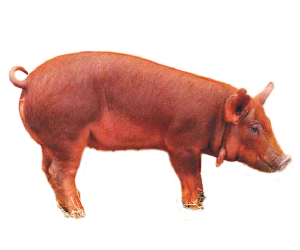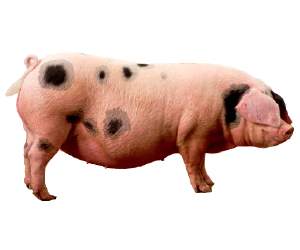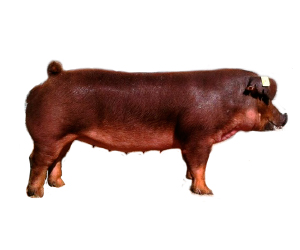CASELLA’S BREEDS AND FARMERS
We only use antibiotic-free, heritage breed American pigs, raised on pasture using traditional methods. Our animals are healthy and happy, the very best of old-world farming here in America.
We are very proud of the heritage breeds, and of our fantastic farmers who work so hard to keep these breeds — some of them very rare — viable and available so that I can bring them to you, with love and respect, revitalizing the methods the original craftsman in my family have passed on to me.
Each breed is distinct, with superior genetics and subtle differences in flavor, but they are all 100 percent happy and healthy heritage breeds. These are our favorites, followed by an introduction to our farmers, who are true American heroes, the backbone of this great tradition, and the reason I am able to bring you the best salame and prosciutto you have ever tasted.
OUR BREEDS
BERKSHIRE
Yielding brighter pork than most, and featuring a thick, delicious fat cap, Berkshire meat is exceptionally flavorful. Historically the favorite breed of the English royalty, Berkshire pork is reddish/pink in color, balanced, porky and distinctive — often with hints of black pepper and mushroom. The characteristic intramuscular fat that runs through Berkshire meat gives it a smooth texture and melt on the tongue tenderness. Berkshire is the consistent pork of choice for many of the world’s best chef, and because it’s flavor and texture is so well balanced it’s a perennial favorite for every type of ham or salame.
Red Wattle
The Red Wattle was the first breed of pig sourced by our partners at Heritage Foods USA. The Red Wattle was once thought to be extinct, but a wild herd was found in Texas in the 1970s and select farmers have begun breeding them again in small numbers. Currently there are fewer than 1000 registered Red Wattle hogs registered in the United States, and it remains prized for its tender meat and splendid hams.
The Red Wattle is believed to have come to America’s shores in the mid 1700s from New Caledonia, where it populated the backyards of New Orleans’ homes. During the 18th and 19th centuries the locals bred Red Wattles to stand up to the Cajun cuisine. Red Wattle pork is juicy and well marbled, earthy, with a unique beefy robustness with notes of Cinnamon and Spice, that are not easily overwhelmed, making it ideal for strong old-world style salame. Its expressive taste is concentrated and bold.
Gloucestershire Old SpoT
Developed in England, the Gloucestershire Old Spot is a threatened British breed. Nicknamed “orchard pig”, these white pigs with big black spots were developed on fruit orchards, where they gorged themselves on fallen fruit and other treats. Their backyard grazing lifestyles led to the development of their oversized floppy ears, which protect their eyes during foraging and enhance their sense of smell. While this makes the Old Spot excellent foragers the negative impact on their peripheral vision causes the breed to be especially dependent on humans for protection from predators.
Old Spots became rare after World War II, when the shift to intensive pig production reduced interest in outdoor pigs. The breed almost became extinct in the 1960s but is experiencing a renaissance. Their lazy and gluttonous lifestyle yields pork that is fatty, delicious and succulent.
Tamworth
The Tamworth hog is another threatened Heritage breed with fewer than 1000 registered in the United States. Traditionally known as the best "bacon hog”, Tamworths are a thrifty, hardy breed, originating in Ireland, generally larger in size with lean athletic builds. They are known for being a great "dual purpose" pig, producing both stunningly good pork and exceptional bacon. The pig's long angular snout makes it an excellent forager, prized by chefs for its incredible tenderness and clean, sweet porky flavor with subtle notes of minerals and fruit.
Thought to have descended from wild boars via native pig stock of Europe, Tamworths still maintain many "unimproved" traits. When crossed with wild hogs, Tams are known to sometimes produce striped "Iron Age" piglets, similar to those kept in early domestication. The Royal Agricultural Society first recognized the Tamworth in 1885.
Duroc
The Duroc is an older breed of American domestic pig that has become one of the most popular breeds because of its great taste and strong, favorable genetics, but pure Duroc is very hard to find. Duroc meat is crisp and clean — known for great marbling, excellent spareribs and juicy shoulder roasts. Its taste and texture are polished and clean on the palate.
Durocs are a red pig strain developed around 1800 in New England and reputed to trace their ancestry back to the early red pigs first brought over by Columbus and DeSoto from the Guinea coast of Africa. Durocs are especially valued by farmers for their hardiness and quick but thorough muscle growth.
Large Black
Like the Gloucestershire Old Spot the Large Black was developed in backyards and on pasture in Cornwall, Devon, and Somerset, England. Originally know as the Lop Eared Black, the breed was selected for large size and ability to thrive on grazing alone. Its characteristic floppy ears shield its eyes while rooting in the dirt and its dark skin protects it from sunburns during long hours on pasture.
The Large Black gained rapid popularity during the last half of the 1800s, becoming one of the most popular English pig breeds by 1920. The decline in interest for outdoor production pigs after World War II caused the breed to become nearly extinct by 1960.
Today, with increased interest in pasture-raised pork, the Large Black is experiencing a renaissance. While this breed remains very rare — with less than 1000 registered in the United States - its large size, good fat development, and excellent foraging ability has made it popular among farmers and charcutiers. It’s taste is described as Firm, Sweet & Savory, Exquisite, and Delicate.
OUR FARMERS
Thanks to our partnership with Heritage Foods USA, Casella’s is proud to be working with a network of independent family farms, all raising their animals on pasture, with traditional methods. They truly represent the best of American farming, protecting heritage breeds and working hard to promote sustainable, humane, healthy, and happy animals. This is the very best of old-world farming in America.
Lazy S. Farms – La Plata, Missouri
Larry and Madonna Sorrell have worked with Heritage Foods since the beginning in 2002, originally growing heritage turkeys and eventually becoming the undisputed royalty of Red Wattle pigs in the USA. Because of a fierce dedication to the genetic purity of the breed and thanks to relationships with the Amish community that took years to develop, Larry and Madonna are a major reason why the Red Wattle, once critically endangered, has been upgraded on conservation lists by the American Livestock Breeds Conservancy. Larry, like the Wattle itself, is sweet and buttery, but can also be tart and charmingly inconsistent!
Good Farms – just North of Manhattan, Kansas — “The Little Apple”
Craig Good inherited the responsibility of maintaining a passel of the finest Duroc breed pigs in the nation from his father who taught pig husbandry at Kansas State. Craig began working with Heritage Foods in 2006 and over the years transitioned his farm to include numerous rare breeds like the Gloucestershire Old Spot and Tamworth which he also crosses with his Duroc to make deliciously marbled breeds with names like Spot-Rocs and Dur-Worths!
Craig introduced Heritage Foods to many farmers local to him in Manhattan, Kansas including a talented young lamb farmer and a student who raises pigs through the Future Farmers of America. Craig maintains his lovely farm with his wife Amy and it is a favorite stop along the numerous chef farm tours taken over the past decade. In addition to pigs, Craig raises 100% pure Angus beef, which Heritage Foods features once a year during grilling season.
Newman Farm – Myrtle, Missouri
David Newman is a professor of pig science in North Dakota and along with his brother Chris, has continued the tradition of raising the old-line English genetics of the Berkshire breed started by their father more than 40 years ago on their family farm in the Ozarks. The Newmans are responsible for introducing the purest Berkshire genetics to dozens of farms throughout the country and remain among the fiercest proponents of pasture-raised systems that result in the best marbling in the business. First imported to America in 1823, today the Newmans deliver the closest taste to that original stock. Stay tuned for promotions featuring cross breeding experiments from the farm with Berkshires and rare breeds like the Red Wattle and Large Black.
Krapfl Farm – Delhi, Iowa and Halverson Farm – Benard, Iowa
Tom Krapfl and Randy Halverson. Because the Berkshire is not endangered like the Wattle, Old Spot or Tamworth, it allows us to meet an ever-growing demand for pasture-raised pork nationally. Tom’s and Randy’s farms are both certified to be humane by Humane Farm Animal Care, the leading non-profit organization dedicated to improving the lives of farm animals in food production from birth through slaughter. Raising outdoors makes for healthier and happier animals that taste better than their counterparts raised indoors.
Norton Farm – Plattsburg, Missouri
Eric Norton farms an immense property within a stone’s throw of Heritage Foods abbatoir in Trimble, Missouri. His diversified farm includes grains, which he uses as feed for his cattle, and pigs that run wild across vast stretches of the hilly landscape that has been owned by his family for generations. When Eric began working with Heritage Foods in 2006 his Berkshire line was but a small percentage of his overall production but over the years he has selected for the Berkshire genetics and today more and more of his pigs have the black color with white spots on the tip of the feet, nose and tail — trademark characteristics of the breed. Eric is a young farmer with a growing family giving hope that superior, non-industrial pigs have a vibrant future in the area surrounding Kansas City.
Keevhaver Farm – Trimble, Missouri; Baker Farm – Kiron, Iowa; Meyer Farm – Lawson, Missouri
Ben Keevhaver, Trent and Troy Baker, Sharon Meyer. When Heritage Foods first started to ramp up production of heritage pigs at our abattoir in Trimble, Missouri, a number of local farmers called asking if they could also provide pigs for the program. The answer, like usual, was yes as long as they transitioned to raising the Berkshire outdoors, a breed that was readily available to them locally. So over the years the three farms started to ramp up production themselves and now provide excellent pigs on a monthly basis. They are also helping to grow the supply of good, clean and fair pigs in the Kansas City market, good news for the local restaurant scene, which has really taken off in recent years.
Doug Metzger and his family – Seneca, Kansas
Doug Metzger was the first farmer to grow pigs for Heritage Foods and it was he who introduced us in 2005 to Paradise Locker Meats, an abattoir we have worked with ever since. We met Doug and his wife Betty through our original project to introduce rare breed turkeys to the national market and continued to work with him to raise Berkshire pigs and eventually Tamworth pigs, which are considered rare. Doug is a master of agricultural arts and has raised almost everything imaginable over the decades. Doug is a great connector of people and has played a major role in the local ag scene through his diversified farm. Doug is older now and we hope very much that his daughter and son continue to the tradition of farming in the family that was started many generations before. Life Magazine once wrote that Doug’s father had more living descendants than any American – and many of them were farmers.











